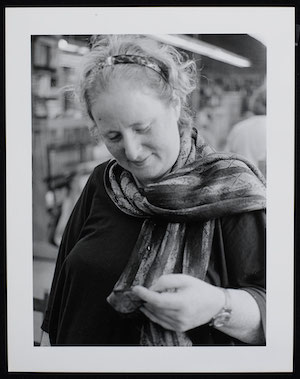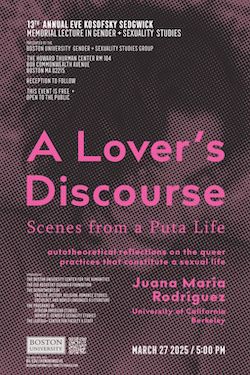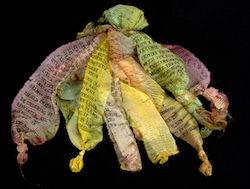BLOG
AN "OPEN MESH OF POSSIBILITIES" SYMPOSIUM AVAILABLE ONLINE
The February 26, 2025 opening symposium for the “Open Mesh of Possibilities” exhibit at the Sallie Bingham Center for Women’s History and Culture is now available to view online here.
RELATED - EVENTS
TRAVEL GRANT RECIPIENT DAVID SEITZ ON WORKING WITH EVE'S ARCHIVE
Fung’s card to Sedgwick. Courtesy of David Seitz
David K. Seitz, associate professor of cultural geography, Harvey Mudd College, was a 2024-2025 recipient of an Eve Kosofsky Sedgwick Research Travel Grant supported by the Foundation. He writes of a serendipitous find in the archive:
I came to the Rubenstein Rare Book & Manuscript Library under the auspices of the Sallie Bingham Center with a particular interest in Sedgwick’s attention to questions of race, class, and empire. Although I certainly imagined that such questions might come up in her correspondence with Richard Fung, the acclaimed Chinese-Trinidadian-Canadian queer experimental filmmaker, I had not anticipated the place of the panda in such exchanges.
More on Seitz’s time in the archive here.
RELATED - GRANTS
PROFESSOR JUANA RODRÍGUEZ PRESENTS THE THIRTEENTH ANNUAL SEDGWICK LECTURE IN GENDER & SEXUALITY STUDIES AT BOSTON UNIVERSITY
Professor Juana María Rodríguez presented the thirteenth annual Sedgwick Lecture in Gender & Sexuality Studies at Boston University on March 27. Dr. Rodríguez is the author of Puta Life: Seeing Latinas, Working Sex (Duke UP 2023); Sexual Futures, Queer Gestures, and Other Latina Longings (NYU Press 2014); and Queer Latinidad: Identity Practices, Discursive Spaces (NYU Press, 2003).
RELATED - EVENTS
AN OPEN MESH OF POSSIBILITIES EXHIBIT ONLINE
“An ‘Open Mesh of Possibilities’: Thinking Queerness with Eve Kosofsky Sedgwick’s Archive,” which “explores the multifaceted ways in which the writings and artwork of Eve Kosofsky Sedgwick (1950 - 2009) bring queerness into life,” is now online. Curated by Katherine Carithers, the exhibit is on display in person at the Sallie Bingham Center at Duke University until August 2, 2025.
RELATED - ARCHIVE
EVE KOSOFSKY SEDGWICK SYMPOSIUM AT DUKE UNIVERSITY
On February 26, 2025, Duke University’s Rubinstein Library is hosting a symposium celebrating the opening of an exhibit exploring the work and legacy of Eve Kosofsky Sedgwick and featuring materials from the Eve Kosofsky Sedgwick archive. This program is in-person. The talks will be recorded and videos will be shared online after the event, but will not be streamed live. Registration is required for the symposium. Register for the event and view the full schedule at the library website. The exhibit will be on display February - August 2025.
The program will include remarks by:
- Jennifer Nash, Jean Fox O’Barr Professor of Gender, Sexuality and Feminist Studies, Duke University
- Adam Frank, Professor of English Languages and Literatures, University of British Columbia
- Katherine Carithers, exhibit curator, Ph.D. candidate, Department of English, Duke University
- Jane Hu, Assistant Professor of English at University of Southern California
- Robyn Wiegman, Professor of the Programs in Literature and Gender, Sexuality, and Feminist Studies, Duke University
- Cindy Patton, Professor Emeritus, Department of Sociology and Anthropology, Simon Fraser University
- Cole Adams, Ph.D. candidate, Program in Literature, Duke University
- Julien Fischer, Candidate Psychoanalyst; Mellon Postdoctoral Fellow, Stanford Humanities Center and Lecturer, Program in Feminist, Gender, and Sexuality Studies, Stanford University.
- Christina Olivares, Ph.D. candidate, Department of English Education, Teachers College at Columbia University
- Annie Sansonetti, Ph.D. candidate, Performance Studies, NYU Tisch School of the Arts




